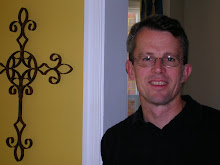Catching the Wind -- FPC sermon excerpt
Wind power.
It can be an incredibly destructive force. The cyclone that hit Burma last week had winds of 120 miles per hour, causing floods and high tidal waves that led to heartbreaking loss of life.
But wind power can also be powerfully good, providing one of our most promising forms of renewable energy. With oil hitting 125 dollars per barrel, we need all the help we can get.
One problem with wind power is that it can be notoriously difficult to catch. The very best winds don’t tend to move at ground level — instead, they do their blowing six miles up in the air, at the height of the jet stream. At that level, the winds are stronger and blow more consistently, carrying up to a hundred times more energy.
So how can humans harness this power? Conventional turbines on the tops of towers won’t get us close enough. We really need to get creative. According to The Economist magazine (June 9, 2007), a company called Sky WindPower has developed a flying generator, one that looks like a cross between a kite and a helicopter. Picture an H-shaped frame with rotors at the ends of the four points, tethered to the ground by a long cable. The rotors provide lift, like the surface of a kite, and as they lift the frame they also turn dynamos that generate electricity. This electricity is then transmitted to the ground through aluminum cables.
But what happens if the wind stops blowing? Here’s the cool part: The dynamos can be used in reverse as electric motors. If the wind slows down, the dynamos turn the rotors to keep the generator in the air.
It seems that if you want to catch the wind, you have to put yourself where the wind is blowing.
I believe that the very same is true for the church. If we are going to tap the limitless energy of Holy Spirit wind power, then we are going to have to position ourselves correctly. Fortunately, the Book of Acts provides a blueprint for building a church that can catch this wind. It suggests that there are four points to put in place, kind of like the four points of a flying generator: Community, Communication, Courage, and Clarity. With these four points in the right place, we can feel “the rush of a violent wind” (Acts 2:2), and capture the energy of the Holy Spirit.
It can be an incredibly destructive force. The cyclone that hit Burma last week had winds of 120 miles per hour, causing floods and high tidal waves that led to heartbreaking loss of life.
But wind power can also be powerfully good, providing one of our most promising forms of renewable energy. With oil hitting 125 dollars per barrel, we need all the help we can get.
One problem with wind power is that it can be notoriously difficult to catch. The very best winds don’t tend to move at ground level — instead, they do their blowing six miles up in the air, at the height of the jet stream. At that level, the winds are stronger and blow more consistently, carrying up to a hundred times more energy.
So how can humans harness this power? Conventional turbines on the tops of towers won’t get us close enough. We really need to get creative. According to The Economist magazine (June 9, 2007), a company called Sky WindPower has developed a flying generator, one that looks like a cross between a kite and a helicopter. Picture an H-shaped frame with rotors at the ends of the four points, tethered to the ground by a long cable. The rotors provide lift, like the surface of a kite, and as they lift the frame they also turn dynamos that generate electricity. This electricity is then transmitted to the ground through aluminum cables.
But what happens if the wind stops blowing? Here’s the cool part: The dynamos can be used in reverse as electric motors. If the wind slows down, the dynamos turn the rotors to keep the generator in the air.
It seems that if you want to catch the wind, you have to put yourself where the wind is blowing.
I believe that the very same is true for the church. If we are going to tap the limitless energy of Holy Spirit wind power, then we are going to have to position ourselves correctly. Fortunately, the Book of Acts provides a blueprint for building a church that can catch this wind. It suggests that there are four points to put in place, kind of like the four points of a flying generator: Community, Communication, Courage, and Clarity. With these four points in the right place, we can feel “the rush of a violent wind” (Acts 2:2), and capture the energy of the Holy Spirit.


0 Comments:
Post a Comment
<< Home